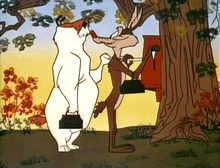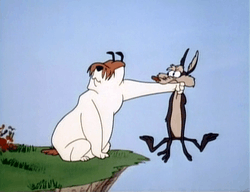Ralph Wolf and Sam Sheepdog
| Ralph E. Wolf and Sam Sheepdog | |
|---|---|
| Looney Tunes character | |
 Sam (left) and Ralph (right) in A Sheep in the Deep | |
| First appearance | Don't Give Up the Sheep (January 3, 1953) |
| Created by | Chuck Jones |
| Voiced by |
Ralph Wolf: Mel Blanc (1951–1963) Sam Sheepdog: Mel Blanc (1951–1963) Jim Cummings (1994) |
| Information | |
| Species |
Ralph Wolf: Wolf Sam Sheepdog: Briard Sheepdog |
Ralph E. Wolf and Sam Sheepdog (E. like Ethelbert) are characters in a series of animated cartoons in the Warner Bros. Looney Tunes and Merrie Melodies series of cartoons. The characters were created by Chuck Jones.
Ralph Wolf (named after a Warner Bros. employee) has virtually the same character design as another Chuck Jones character, Wile E. Coyote—brown fur, wiry body, and huge ears, but with a red nose in place of the Coyote's black one; (usually) white eyes instead of Wile E.'s yellow; and, occasionally, a fang protruding from his mouth. He also shares the Coyote's appetite, and persistent use of Acme Corporation products, but he covets sheep instead of road runners and, when he speaks, doesn't have the upper-class accent or the egotistical bearing of the Coyote. Another crucial difference is that of personality: Ralph does not have the fanatical drive of the Coyote in pursuing his prey, preferring to abandon his chase at the end of the working day.
Sam Sheepdog, by contrast, is a large, burly Berger de Brie (Briard Sheepdog) with white or tan fur and mop of red hair that usually covers his eyes. He very rarely runs and tends to be sedentary in his movements. He does, however, possess sufficient strength to incapacitate Ralph with a single punch once he catches him.
Original appearances
Inspired by the Friz Freleng cartoon The Sheepish Wolf of a decade earlier (October 17, 1942),[1] Chuck Jones created Ralph and Sam for a series of shorts. The first of these was Don't Give Up the Sheep, released on January 3, 1953.
The cartoon proved a success, prompting Jones to repeat the formula five more times between 1953 and 1962. In 1963, ex-Jones animators Phil Monroe and Richard Thompson also starred the duo in their cartoon Woolen Under Where.
The series is built around the idea that both Ralph and Sam are just doing their jobs. Most of the cartoons begin at the beginning of the workday, in which they both arrive at a sheep-grazing meadow, exchange pleasant chitchat, and punch into the same time clock. Work having officially begun, Ralph repeatedly tries very hard to abduct the helpless sheep and invariably fails, either through his own ineptitude or the minimal efforts of Sam (he is frequently seen sleeping), who always brutally punishes Ralph for the attempt. In many instances there are also multiple copies of Ralph and particularly Sam.
At the end-of-the-day whistle, Ralph and Sam punch out their time cards, again chat amiably, and leave, presumably only to come back the next day and do it all again. Both Ralph and Sam are performed by voice actor Mel Blanc. In "A Sheep In The Deep" the workday is interrupted by a lunch break, which they also conduct amiably. The operation seems to run 24 hours a day or at least into another shift, as when Ralph and Sam "punch out" they may also run into their nighttime replacements, Fred and George, respectively (see Sheep Ahoy: Inconsistency in naming). In some of their earlier appearances Ralph and Sam are named inconsistently: in particular the Sheepdog's shift replacement sometimes addresses him as "Ralph".
Shorts
- Don't Give Up the Sheep (1953) Has MCMLI in opening. - Sam is referred to as Ralph.
- Sheep Ahoy (1954) - Sam is referred to as Ralph, Ralph is referred to as George, and George is referred to as Sam.
- Double or Mutton (1955)
- Steal Wool (1957)
- Ready, Woolen and Able (1960)
- A Sheep in the Deep (1962)
- Woolen Under Where (1963)
Derivative appearances
Sam and Ralph have featured in a handful of Warner Bros. projects since the closing of the studio's animation department. Sam has a cameo in the 1988 film Who Framed Roger Rabbit during the final scene, and they occasionally feature in the Looney Tunes Comics published by DC Comics.
- Sheep, Dog, 'n' Wolf (also known as Sheep Raider) for the original Sony PlayStation and PC, published by Infogrames, is a faithful adaptation of the series' sheep-abducting schemes. The Road Runner makes a cameo appearance in the training level and also the final level, racing in the desert against Ralph. Ironically, neither Ralph or Sam speak within this game.
- Sam Sheepdog appeared in the Taz-Mania episode "Mutton for Nothing" voiced by Jim Cummings. In this episode, Taz was sent by the "Predators "R" Us" temp agency to cover for Ralph Wolf while he's on vacation. Taz tries unsuccessfully to steal the sheep from Sam Sheepdog. A bit of character confusion is at play in this episode as Sam references Ralph as being "that Coyote."
- Sam makes a cameo appearance in the film Space Jam. Though he is mostly seen in the background in the audience during the final basketball match between the Tune Squad and the Monstars, he is seen putting on rabbit ears while cheering for Bugs Bunny, and is later visibly shocked when one of the players is squashed by a Monstar named Pound.
- Ralph and Sam make a brief cameo in the 2003 feature film Looney Tunes: Back in Action. In the movie, Ralph and Sam are sitting at the same table eating lunch. When Ralph reveals to Sam that he finally caught a sheep, Sam grabs him by the neck and continually slaps him across the face.
- Ralph and Sam made an appearance in Bah, Humduck! A Looney Tunes Christmas.
- Sam Sheepdog appears in The Looney Tunes Show opening.
Pop culture references

Ralph and Sam have become a sort of American cultural shorthand for "the usual suspects" or "the loyal opposition," describing two adversaries who have opposed each other for so long and become so familiar with each other that they've come full circle and are now nearly friendly.
One example of this was on the episode "Donut Run" of the television program Veronica Mars, wherein Veronica greeted rival private detective Vinnie Van Lowe with "Mornin' Sam," and he replied, in kind, "Mornin' Ralph."
Chris Rock mentions Ralph and Sam in his book Rock This!. According to the text, a white classmate of Rock's who racially harassed him in high school not only resurfaced years later as his chauffeur, but also attempted to be amicable and suggest they get together for coffee. Rock employs the "time clock" concept to racial tensions in schools by asserting his tormentor was simply playing the role he was dealt.
The NewsRadio episode "Twins" played with the reference in reverse. Bill McNeal and Jimmy James pass each other while stepping through Dave's window. Jimmy (the station owner) says, "Mornin' Sam," Bill (the office troublemaker) replies, "Mornin' Ralph," and Jimmy comments, "I love that joke."
A deleted scene for the Family Guy episode "Tales of a Third Grade Nothing" featured Peter Griffin as Sam Sheepdog at the time clock with Ralph Wolf.
In a Twitter conversation on June 2, 2012, Howard Stern Show producer Gary Dell'Abate tried to reference the characters, but mistakenly called them Roadrunner and Coyote. Dell'Abate got his nickname "Baba Booey" after misquoting another cartoon character, Quick Draw McGraw.
In the episode "Blood in the Water" of the USA Network legal drama Suits, Louis Litt compares his relationship with Harvey Specter to "Sam and Ralph" in a conversation with Mike Ross. Explaining to Ross that for years Harvey and he would butt heads during office hours, but at the end of the day they'd still be on friendly terms. Litt then finishes the analogy by saying that recently Specter had changed and that it now feels like Harvey's 'always on the clock.'
Journalist Mark Leibovich mentions Ralph and Sam in an October 2016 New York Times Magazine profile of Hillary Clinton's presidential campaign, as a metaphor for candidates during previous, more predictable presidential campaigns.[2]
References
- ↑ "The Sheepish Wolf". www.bcdb.com, May 13, 2012
- ↑ http://www.nytimes.com/2016/10/16/magazine/hillary-clinton-campaign-final-weeks.html